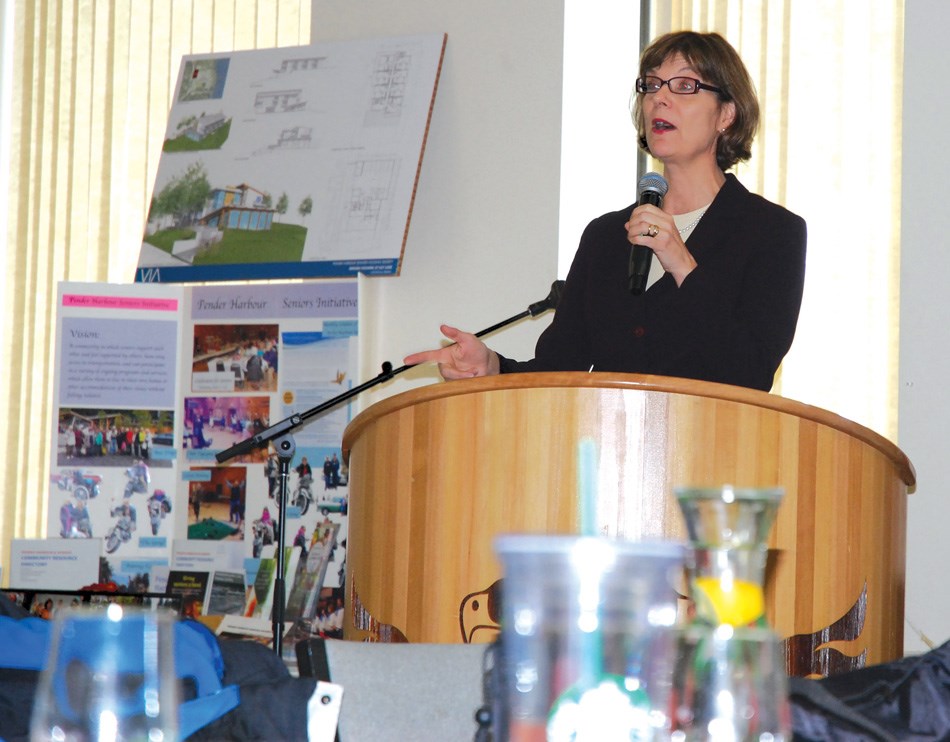The province’s Seniors Advocate used a mix of humour and statistic to paint a picture of long-term care and home care in B.C. during a speech last week in Sechelt.
Almost 200 people were in the audience for Isobel Mackenzie’s keynote address at a March 3 seniors conference organized by the Community Resource Centre.
Mackenzie opened by countering some common myths about B.C.’s aging population, notably the idea of a pending “Grey Tsunami.” She said about 17 per cent of people in the province are over 65, and that’s projected to hit 24 per cent by 2031, which is where Japan, Italy and some Nordic countries already are.
She also knocked down the myth of seniors as a drain on the economy expecting “all of their care needs met by the working population, which has reduced to two guys in a sawmill up in Powell River holding up the entire economy of British Columbia.”
According to Mackenzie, the data shows that about half of people over the age of 75 are living on annual incomes of $22,000 or lower.
And most, even over 85 (the average age of people in residential care facilities), live completely independently. “The overwhelming odds [are] that everybody in this room is going to live in their own place for the rest of their years,” she pointed out.
Moreover, Mackenzie said, the vast majority of those people are covering their own costs for the services they need to continue living at home.
“Over 70 per cent of seniors over 85 live completely independently on their own dime – we want to remember that when we create this [impression of] the big burden and the sky’s going to fall … The overwhelming majority of seniors are taking care of themselves.”
About 13 per cent of people in that age range use subsidized home support.
Last September, the Office of the Seniors Advocate released the results of its survey on home support. It found that 78 per cent of clients felt their needs were mostly or always met.
That said, hours for subsidized home support have been dropping.
“It’s very clear the family caregiver is taking on a greater burden,” Mackenzie said. “The biggest transfer of burden has been from the public system to the caregiver, because the people are still at home … Clearly these family caregivers are providing tremendous, tremendous amounts of care.”
She said there’s not enough flexibility in the system, giving the example of a man who’s able to help his wife with bathing, but can’t cook or is physically unable to manage cleaning, only to find the home support program in his area provides help bathing, but not with household chores.
Her office’s review of home support is due out in June. “Our policy is not matching our practice – number one. Number two – the policy has to be more flexible around the services it provides and recognize that every family is different in terms of the skills and talents they bring to the table to care for their loved one … We need to align financial incentives and we need to recognize that a lot of people are going to be able to provide better for their loved one if we just give them the money.”
In her overview of long-term care, Mackenzie avoided the current debate over the deal between Vancouver Coastal Health and Trellis Seniors Services to contract beds in a facility the company plans to build in Sechelt.
Her only mention of the proposal, which includes the closure of Shorncliffe and Totem Lodge, was when she noted that the number of long-term beds continues to increase. “I know there’s a big brouhaha here, but at the end of the day you’re getting 20 new beds. [It’s] through a means I’m not sure all of you agree with, but you’re getting 20 new beds,” she said.
Mackenzie also predicted the government might be ready to take action soon on staffing shortages in long-term care, which was highlighted in her office’s recently released Residential Care Facilities Quick Facts Directory. The data in the directory shows most facilities are not meeting the Ministry of Health guideline of 3.36 hours of care per resident, per day. She said that’s only part of the issue. “The funded hours of care is about the money, but once you have the money you’ve got to have the people to hire and you’ve got to have the right people to hire.”
The Office of the Seniors Advocate is working to complete a comprehensive survey of long-term care residents and their families. Mackenzie said thousands of volunteer hours have gone into collecting what she expects will amount to between 12,000 and 13,000 responses.
The report will include information at the provincial, health authority, and facility level, and Mackenzie said including families, or the residents’ most frequent visitors, could yield some interesting results. “Do the daughter’s ideas [about good long-term care] conform with [her] mom’s ideas? We’re going to find out.”
Mackenzie said she also had to fight to get a key question included: Do you want to be here? “I want to see if the answers to all the other questions are different based on whether a person wants to be there, or doesn’t want to be there.”
Mackenzie also expects important data on another key issue to come out of the survey. “There’s a big debate – private versus public. We’re going to [be able] to tell if there’s a pattern that shows people in public facilities are happier. We don’t know, but the data will tell us,” she told the audience.



